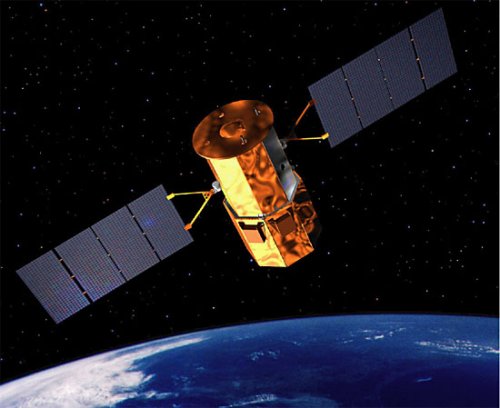Atmospher Sci & Global Chg
Research Highlights
February 2009
Satellite Will Get a Better "Look" at Airborne Particles
New measurement method named as one of the most noteworthy contributions to atmospheric science
Results: A team of U.S. and French scientists has come up with a novel way to measure, from space, tiny atmospheric particles that affect global warming. A NASA satellite to be launched this summer will use the new approach to reveal global climate change patterns.
Aerosols, which are tiny bits of dust, soot, and other material found in Earth's atmosphere, affect the climate by increasing or decreasing the amount of solar energy the Earth system absorbs. Satellites can measure sunlight reflected by the Earth system, deriving important properties of atmospheric aerosols worldwide. This gives scientists a global climate "picture" over time. But satellites have a hard time measuring aerosols over land, because surfaces such as deserts, forests, grasslands, snow, and ice reflect sunlight so differently.
The new method uses highly accurate remote sensing measurements of light polarization for a broad range of wavelengths and viewing angles. Light becomes polarized when it hits a surface and reflects back. That extra information reveals more about light and aerosol reflection. The new method uses measurements from the longer wavelengths of light to estimate surface polarization properties accurately, and it measures the amount and properties of aerosols from shorter-wavelength light. The end result: a more accurate representation of how aerosols influence the Earth's energy balance and climate.
"This fills an important gap that the science community has struggled with—realistically measuring aerosols over the Earth's land surfaces, where people usually generate them," said Dr. Beat Schmid, a Pacific Northwest National Laboratory atmospheric scientist who served on the research team. "When used by satellites, this method will be more accurate than anything else out there," he said. Schmid serves on the science advisory group for NASA's Glory mission, which will send the light-polarization setup into space for the first time.
Scientists will use the method with an instrument called an aerosol polarimetry sensor that launches with the satellite in June 2009. It's the first satellite mission dedicated to understanding the effects of particles in the atmosphere. After the satellite launches from Vandenberg Air Force Base in California, it will join a "train" of others that orbit the Earth once every 100 minutes.
The research team isn't the only ones touting the significance of the novel approach. The Journal of Geophysical Research selected the research as an editor's highlight. This means it's in the top five percent of extraordinary contributions to atmospheric science published in the Journal annually.

Scientists have figured out how to get much better satellite measurements of airborne particles over the Earth's land surfaces, where many pollutants originate. (Image: NASA Glory satellite, artist’s conception.)
Method: The team tested the new approach with an aircraft version of the aerosol polarimetry sensor in two situations. The first was in clear skies over the U.S. Southern Great Plains site of DOE's Atmospheric Radiation Measurement Climate Research Facility. The second test involved polluted conditions, flying over a thick smoke plume from a wildfire in the Mojave desert of Southern California. Results from both tests showed that the new method provides measurements of aerosol properties that are within the same range of those measured directly from ground-based instruments known as sun and sky radiometers.
Why it matters: Aerosols are one of the largest sources of uncertainty in assessing climate change. The new method, used with satellites, will enable scientists to measures airborne particles more accurately from space than ever before. Better measurements lead to more accurate climate predictions.
What's next: The satellite is expected to collect and send aerosol measurements back to Earth for three years.
Acknowledgments: The research was funded by NASA Goddard Institute for Space Studies, NASA Radiation Sciences Program, and DOE's Atmospheric Radiation Measurement Program. In addition to Schmid, other researchers included Fabien Waquet from Université des Sciences et Technologies de Lille, France; Brian Cairns, Michael Mishchenko and Larry Travis from NASA Goddard Institute for Space Studies; and Jacek Chowdhary and Kirk Knobelspiesse from Columbia University. PNNL's involvement is part of its quest to transform the prediction of climate change and its impacts.
Reference: Waquet, F., B. Cairns, K. Knobelspiesse, J. Chowdhary, L. D. Travis, B. Schmid, and M. I. Mishchenko. January 2009. "Polarimetric Remote Sensing of Aerosols over Land." J. Geophys. Res., 114, D01206, doi:10.1029/2008JD010619.
